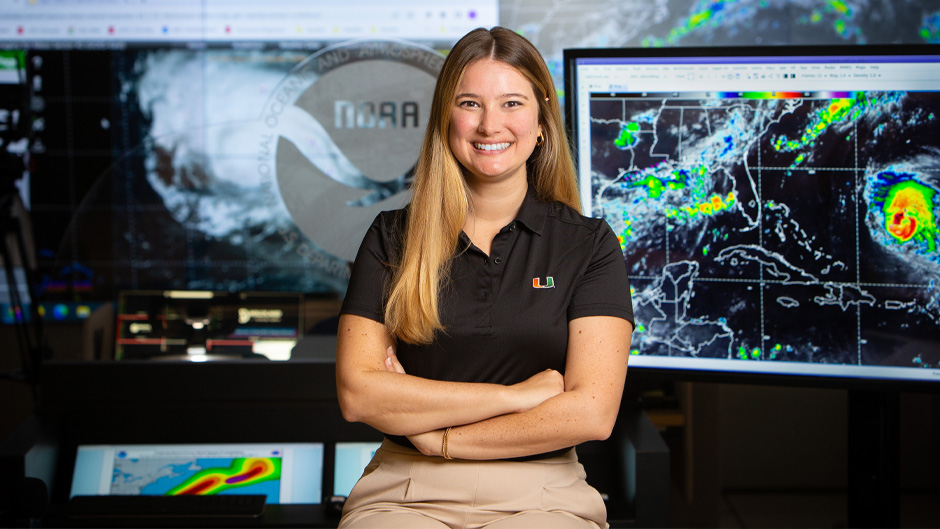Hurricane Wilma’s explosive intensification stunned forecasters. Within 24 hours, it transformed from a tropical storm to a Category 5 cyclone with a peak wind speed of 184 miles per hour.
One of those tracking the storm was 10-year-old Samantha Camposano, a Collier County, Florida, girl who was fascinated by weather.
As Wilma crossed the Yucatán Peninsula and entered the Gulf of Mexico, Camposano logged onto the National Hurriane Center’s website to monitor the storm’s movement. She grew more apprehensive by the hour as the cyclone accelerated to the northeast toward Southwest Florida, with her hometown in its crosshairs.
“It was the same year Katrina hit New Orleans. I was only in the fifth grade then, but I knew the damage storms could wrought,” Camposano said of the then-2005 record-setting Atlantic hurricane season, which saw 28 named storms develop, including four Category 5 hurricanes, one of which was Wilma.
The storm would slam into Southwest Florida on Oct. 24, 2005, as a Category 3 hurricane, flooding streets, knocking out power, and tearing roofs off houses. “We got by with only minor damage, with uprooted vegetation being the worst of it,” Camposano said.
Seventeen years later, her fascination with storms hasn’t waned. Only now, her interest has far-reaching implications for the forecasting of, and preparation for, hurricanes.
As a senior research associate at the University of Miami’s Cooperative Institute for Marine and Atmospheric Studies (CIMAS), Camposano puts new storm-forecasting tools and models through their paces, running them through a series of experiments and demonstrations before they even get into the hands of meteorologists.
“It’s like being given the keys to a million-dollar sports car,” the University of Miami double alumna said of her role in helping to test and evaluate emerging technologies that will improve hurricane forecasting. “Transitioning research findings into valuable operational tools is the part of hurricane research many people don’t see. But it couldn’t be more critical.”
Now in her second year at CIMAS, which is part of the Rosenstiel School of Marine, Atmospheric, and Earth Science, Camposano has tested everything from software that assists meteorologists in determining when to issue tropical cyclone wind watches and warnings to a cloud-based advanced weather information system that integrates meteorological and hydrological data with satellite and radar imagery.
Her work supports the Hurricane Research Division of the National Oceanic and Atmospheric Administration’s (NOAA) Atlantic Oceanographic and Meteorological Laboratory. And on at least one day out of the week, she travels to the National Hurricane Center in Westchester, Florida, working side-by-side with other scientists in the facility’s new William M. Lapenta Laboratory. The lab, named in honor of the late director of the National Centers for Environmental Prediction, is where the crucial “research to operations work is done,” Camposano said.
While the genesis of Camposano’s interest in tropical cyclones can be traced back to the time when she was a little girl tracking storms on her desktop computer, her first serious investigation into hurricane research didn’t begin until she became a student at the Rosenstiel School.
She earned her bachelor’s degree in meteorology and marine science. Then, as a graduate student in the Master of Professional Science program, Camposano evaluated tropical cyclone vortex structure and steering flow and analyzed the effectiveness of an experimental version of NOAA’s Hurricane Weather Research and Forecasting computer model, finding that the model did not contain any biases in its storm predictions.
After she earned her master’s degree in 2018, Camposano worked briefly at the National Weather Service in Silver Spring, Maryland. But getting back to Miami was her goal.
“I knew that if I was going to be a hurricane researcher worth my salt, the Rosenstiel School was where I had to be,” she said. “Its proximity to world-class agencies like NOAA, which is just across the street, and having its own world-class labs and experts was too big a draw.”
Her research, she noted, carries with it the overarching goal of benefitting everyone.
“Our work doesn’t stop with forecasts,” Camposano said. “Our goal is to assess tools and products from a more holistic standpoint than ever before to help social scientists, broadcast meteorologists, emergency managers, first responders, and others. Our vision is to expand and to include the entire value chain of people who are involved, right down to the public.”

